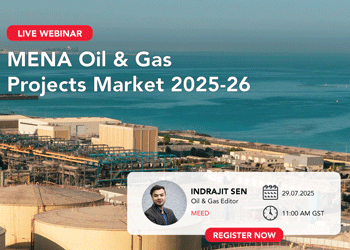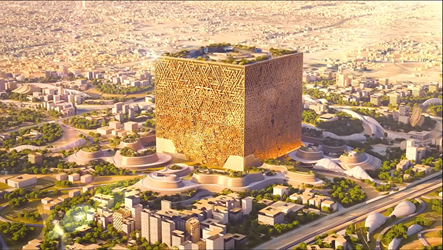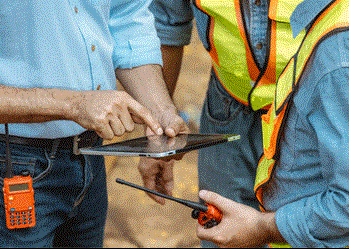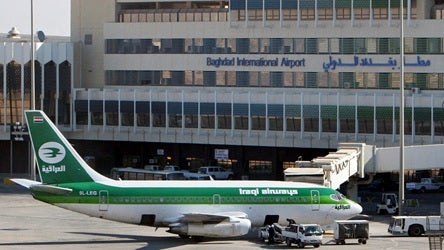Saudi power projects hit record high
21 February 2025

Saudi Arabia has entered what could be the busiest period for power generation capacity buildout in its history.
According to data from regional projects tracker MEED Projects and MEED, power generation projects with a total capacity of 53GW are under construction, or are about to start construction following the formal award of contracts or the selection of bidders.
Generation and cogeneration plants powered by natural gas account for two-thirds, or 66.7%, of the total capacity under construction, with renewable energy plants – mainly solar – accounting for the rest.
Solar and wind power plants dominate the pre-execution pipeline, however, accounting for about 94% of the capacity that is currently under bid or prequalification.
The total thermal and renewable generation capacity being planned and tendered in Saudi Arabia, inclusive of projects in the study and design phases, stood at about 80GW as of February 2025.
The major capacity buildout is in line with the kingdom's liquid displacement programme, as well as its target for renewable energy sources to account for half its electricity production by 2030.
According to the Energy Institute, Saudi Arabia's total electricity generation in 2023 reached 422.9 terawatt-hours (TWh). Oil accounted for 152.1TWh, or about 36% of the total, while natural gas accounted for 265TWh, or 63%, and renewables made up 5.8TWh or 1%.
CCGT plants
The urgency of displacing the kingdom's oil-fired fleet underpins the successive contract awards for combined-cycle gas turbine (CCGT) power generation plants, which are being developed as independent power projects (IPPs) or via engineering, procurement and construction (EPC) contracts.
About 47% of the 35.8GW of gas-fired capacity that is under construction is being built via an EPC or design-and-build model, mainly by Saudi Electricity Company (SEC). The rest is being constructed using an IPP model.
Of the total thermal capacity under construction, about 45% will be generated by greenfield power plants that are being built as an expansion to existing power generation facilities in the kingdom.
Chinese contractors such as Sepco 3 and China Energy Engineering Corporation are among the firms constructing 10 of the 19 gas-fired power generation and cogeneration plants that are under execution in Saudi Arabia. An 11th plant is being constructed by Sepco 3 in partnership with Doosan Enerbility of South Korea. The 11 plants equate to a capacity of about 21GW.
South Korean contractors – primarily Doosan and Samsung C&T – are involved in four of the 19 projects.
"I think the Chinese EPC contractors are already at capacity, so SEC has started tapping Egyptian and Spanish EPC contractors," an industry source tells MEED, in reference to Tecnicas Reunidas, Orascom and Elsewedy, which were selected last year to undertake the EPC contracts for several CCGT plants.
The peak for new gas-fired contract awards may have passed, however.
Data from MEED Projects indicates that four cogeneration plants with a combined capacity of about 1.5GW are in the pre-execution stage. Meanwhile, at least two gas-fired IPP schemes – Shoaiba and Al-Shuqaiq – are currently under study, each with a planned capacity of 2.6GW.
However, the possibility of an unexpected new project, like the 3GW expansion of the Qurayyah IPP, which was announced on 20 February, cannot be ruled out.
Renewables
A reverse trend could be seen for renewable solar power generation capacity.
As of February 2025, nearly all renewable energy capacity under construction in Saudi Arabia is being developed as IPPs.
About 43% of these IPPs are publicly tendered by the principal buyer, Saudi Power Procurement Company (SPPC). The rest are directly negotiated by Saudi sovereign wealth vehicle the Public Investment Fund (PIF) and the dominant local utility developer, Acwa Power.
The pre-execution pipeline for solar and wind energy projects that will be procured by SEC and gigaproject developer Neom is extensive, especially given that the Energy Ministry has issued a directive that up to 20GW of renewable energy capacity be procured annually until 2030, subject to demand growth.
"It is a massive pipeline," notes a Dubai-based senior transaction adviser.
However, he also notes that a re-scoping process is under way, especially for renewable energy projects that are designed to cater to Neom, the $500bn development in northwestern Saudi Arabia, which aims to be powered 100% by renewables by 2030.
Issues related to land allocation may also arise, if they haven't already, notes another industry expert.
The deployment of additional renewable energy capacity also requires a major battery energy storage system buildout. Efforts towards this got under way last year to ensure the flexibility of the electricity grid.
"The question is how many batteries they will need and how many batteries will be available to support that ambition," the source said.
Data centres
In addition to the liquid displacement programme and the 50% renewable energy production target by 2030, Saudi Arabia has been seeing a major uptick in data centre construction projects, in line with a plan to become a major artificial intelligence (AI) hub.
Hyperscalers such as Amazon Web Services, Google and Microsoft plan to expand their digital or cloud infrastructure in Saudi Arabia in line with this strategy. These and other AI players, as well as local firms such as DataVolt, Ezditek, Alfanar and the UAE-based Gulf Data Hub, pledged about $15bn of investments in this type of infrastructure during the Leap technology conference, which took place in Riyadh on 9-12 February. More investments are expected to be announced in the coming months and years.
These projects, assuming they all come to fruition, will significantly increase computing, cooling and overall electricity demand. The need to make these advanced data centres as sustainable as possible will also further incentivise the kingdom's national renewable energy programme.
JOIN THE LEADERS BUILDING VISION 2030 AT THE 3RD EDITION OF MEED's SAUDI GIGAPROJECTS SUMMIT
12-14 May – Riyadh, Saudi Arabia
CLICK HERE TO REGISTER YOUR INTEREST
Exclusive from Meed
-
 WEBINAR: Mena Oil & Gas Projects Market 2025-26
WEBINAR: Mena Oil & Gas Projects Market 2025-2610 July 2025
-

-
 Chinese firm wins Mid Island Parkway tunnelling deal
Chinese firm wins Mid Island Parkway tunnelling deal10 July 2025
-
 Iraq tenders Baghdad airport PPP project
Iraq tenders Baghdad airport PPP project9 July 2025
-

All of this is only 1% of what MEED.com has to offer
Subscribe now and unlock all the 153,671 articles on MEED.com
- All the latest news, data, and market intelligence across MENA at your fingerprints
- First-hand updates and inside information on projects, clients and competitors that matter to you
- 20 years' archive of information, data, and news for you to access at your convenience
- Strategize to succeed and minimise risks with timely analysis of current and future market trends

Related Articles
-
 WEBINAR: Mena Oil & Gas Projects Market 2025-26
WEBINAR: Mena Oil & Gas Projects Market 2025-2610 July 2025
Date & Time: Tuesday 29 July 2025 | 11:00 AM GST
Agenda:
1. Summary of the Mena oil, gas and petrochemicals projects market
2. Summary description of the main megaprojects, including project programmes
3. Analysis of active contracts and spending to date
4. Analysis of top contracts by work already awarded
5. Long-term capital expenditure outlays and forecasts
6. Highlights of key contracts to be tendered and awarded over the next 18 months
7. Top contractors and clients
8. Breakdown of spending by segment, ie, oil, gas, petrochemicals – upstream, downstream, onshore and offshore
9. Q&A session
https://image.digitalinsightresearch.in/uploads/NewsArticle/14241705/main.gif -
 New Murabba signs up South Korean firm for design works
New Murabba signs up South Korean firm for design works10 July 2025
Register for MEED’s 14-day trial access
Saudi Arabia’s New Murabba Development Company (NMDC) has signed a memorandum of understanding (MoU) with South Korea’s Heerim Architects & Planners to explore further design works on assets at the 14 square-kilometre New Murabba downtown project.
According to an official statement: “Heerim Architects & Planners will explore distinctive architectural plans that complement the development’s masterplan, with special focus on anchor assets, linear parks and smart city features.”
New Murabba CEO Michael Dyke signed the agreement last week during the company’s Investment and Partnership Forum in Seoul.
At the event, NMDC also signed an MoU with South Korea’s Naver Cloud Corporation to explore technological solutions for delivering the New Murabba downtown project.
According to an official statement: “The three-year agreement covers exploring innovative technology and automation to support the delivery of New Murabba, including robotics, autonomous vehicles, a smart city platform and digital solutions for monitoring construction progress.”
NMDC is in Seoul to examine technological offerings, assess financing options and showcase the investment opportunities available for the New Murabba downtown development.
The statement added that the excavation works for The Mukaab, the centrepiece of the overall development, have now been completed.
The Mukaab is a Najdi-inspired landmark that will be one of the largest buildings in the world. It will be 400 metres high, 400 metres wide and 400 metres long. Internally, it will have a tower on top of a spiral base and a structure featuring 2 million square metres (sq m) of floor space designated for hospitality. It will feature commercial spaces, cultural and tourist attractions, residential and hotel units, and recreational facilities.
Downtown destination
The New Murabba destination will have a total floor area of more than 25 million sq m and feature more than 104,000 residential units, 9,000 hotel rooms and over 980,000 sq m of retail space.
The scheme will include 1.4 million sq m of office space, 620,000 sq m of leisure facilities and 1.8 million sq m of space dedicated to community facilities.
The project will be developed around the concept of sustainability and will include green spaces and walking and cycling paths to promote active lifestyles and community activities.
The living, working and entertainment facilities will be developed within a 15-minute walking radius. The area will use an internal transport system and will be about a 20-minute drive from the airport.
The downtown area will feature a museum, a technology and design university, an immersive, multipurpose theatre, and more than 80 entertainment and cultural venues.
 READ THE JULY 2025 MEED BUSINESS REVIEW – click here to view PDF
READ THE JULY 2025 MEED BUSINESS REVIEW – click here to view PDFUAE and Turkiye expand business links; Renewed hope lies on the horizon for trouble-beset Levant region; Gulf real estate momentum continues even as concerns emerge
Distributed to senior decision-makers in the region and around the world, the July 2025 edition of MEED Business Review includes:
> AGENDA: UAE-Turkiye trade gains momentum> INTERVIEW 1: Building on UAE-Turkiye trade> INTERVIEW 2: Turkiye's Kalyon goes global> INTERVIEW 3: Strengthening UAE-Turkiye financial links> INTERVIEW 4: Turkish Airlines plans further growth> CURRENT AFFAIRS: Middle East tensions could reduce gas investments> GCC REAL ESTATE: Gulf real estate faces a more nuanced reality> PROJECTS MARKET: GCC projects market collapses> INTERVIEW 5: Hassan Allam eyes role in Saudi Arabia’s transformation> INTERVIEW 6: Aseer region seeks new investments for Saudi Arabia> LEADERSHIP: Nuclear power makes a global comeback> LEVANT MARKET FOCUS: Levant states wrestle regional pressures> GULF PROJECTS INDEX: Gulf projects index continues climb> CONTRACT AWARDS: Mena contract award activity remains subdued> ECONOMIC DATA: Data drives regional projects> OPINION: A farcical tragedy that no one can endTo see previous issues of MEED Business Review, please click herehttps://image.digitalinsightresearch.in/uploads/NewsArticle/14239016/main.jpg -
 Chinese firm wins Mid Island Parkway tunnelling deal
Chinese firm wins Mid Island Parkway tunnelling deal10 July 2025

Register for MEED’s 14-day trial access
Beijing-headquartered China Railway Tunnel Engineering Group has won a $60m subcontract for the tunnelling works on package 1B of the Mid Island Parkway project in Abu Dhabi.
Package 1B entails the construction of a cut-and-cover tunnel to cross the Khor Laffan Channel, which is the area between the Saadiyat and Um-Yifeenah islands.
The tunnel, which will be between 900 metres and 1 kilometre (km) long, is being constructed on a design-and-build basis and will tie in to packages 1A and 1C.
The project is being jointly constructed by a joint venture of local firm Yas Projects (Alpha Dhabi Holding) and Beijing-based China Railway International Group.
In June last year, MEED exclusively reported that Abu Dhabi's Department of Municipality & Transport had awarded contracts for three packages for phase one of the Mid Island Parkway Project (MIPP), as part of the Plan Capital urban evolution programme.
Phase one will start at the existing Saadiyat Interchange, which will connect the E12 road to the MIPP, and will end with the recently constructed Um-Yifeenah Highway.
It comprises a dual main road with a total length of 8km, including four traffic lanes in each direction, two interchanges, a tunnel and associated infrastructure works.
MIPP phase one is further divided into packages 1A, 1B and 1C, which were awarded separately.
The project ownership has been transferred from Aldar Properties to Abu Dhaibi's Department of Municipalities & Transport.
Previously, it was transferred from Abu Dhabi General Services Company (Musanada) to Aldar Properties, and the project was included in the Abu Dhabi Investment Office's public-private partnership project pipeline.
 READ THE JULY 2025 MEED BUSINESS REVIEW – click here to view PDF
READ THE JULY 2025 MEED BUSINESS REVIEW – click here to view PDFUAE and Turkiye expand business links; Renewed hope lies on the horizon for trouble-beset Levant region; Gulf real estate momentum continues even as concerns emerge
Distributed to senior decision-makers in the region and around the world, the July 2025 edition of MEED Business Review includes:
> AGENDA: UAE-Turkiye trade gains momentum> INTERVIEW 1: Building on UAE-Turkiye trade> INTERVIEW 2: Turkiye's Kalyon goes global> INTERVIEW 3: Strengthening UAE-Turkiye financial links> INTERVIEW 4: Turkish Airlines plans further growth> CURRENT AFFAIRS: Middle East tensions could reduce gas investments> GCC REAL ESTATE: Gulf real estate faces a more nuanced reality> PROJECTS MARKET: GCC projects market collapses> INTERVIEW 5: Hassan Allam eyes role in Saudi Arabia’s transformation> INTERVIEW 6: Aseer region seeks new investments for Saudi Arabia> LEADERSHIP: Nuclear power makes a global comeback> LEVANT MARKET FOCUS: Levant states wrestle regional pressures> GULF PROJECTS INDEX: Gulf projects index continues climb> CONTRACT AWARDS: Mena contract award activity remains subdued> ECONOMIC DATA: Data drives regional projects> OPINION: A farcical tragedy that no one can endTo see previous issues of MEED Business Review, please click herehttps://image.digitalinsightresearch.in/uploads/NewsArticle/14238039/main3047.gif -
 Iraq tenders Baghdad airport PPP project
Iraq tenders Baghdad airport PPP project9 July 2025
Register for MEED’s 14-day trial access
Iraq’s Ministry of Transport and the General Company for Airport & Air Navigation Services have released a tender inviting firms to bid for a contract to develop Baghdad International airport on a public-private partnership (PPP) basis.
The notice was issued in July, and the submission deadline is in September.
According to an official statement posted on its website, Iraq’s Ministry of Transport said that 10 out of 14 international consortiums that expressed interest in the project earlier this year have been prequalified to compete for the tender.
The scope of the estimated $400m-$600m project involves rehabilitating, expanding, financing, operating and maintaining the airport. It is the first airport PPP project to be launched in Iraq.
The initial capacity of the airport is expected to be around 9 million passengers, which will be gradually increased to 15 million passengers.
The International Finance Corporation (IFC), a member of the World Bank Group, is the project’s lead transaction adviser.
Iraq is already developing the Baghdad and Najaf-Karbala metro projects using a similar PPP model.
Earlier this month, MEED reported that Iraq intends to retender the contract to develop and operate the Baghdad Metro project, following the award of the estimated $2.5bn contract last year.
According to local media reports, Nasser Al-Assadi, adviser to Prime Minister Mohammed Sudani, stated that the previous developers had overestimated the project budget; therefore, the government will relaunch the entire process to implement the project.
https://image.digitalinsightresearch.in/uploads/NewsArticle/14229008/main.jpg -
 Contractors prepare revised bids for Roshn stadium
Contractors prepare revised bids for Roshn stadium9 July 2025

Register for MEED’s 14-day trial access
Saudi gigaproject developer Roshn has invited firms to submit revised commercial proposals by 24 July for a contract to build a new stadium adjacent to the National Guard facilities to the southwest of Riyadh.
Known as the National Guard Stadium, it will be delivered on an early contractor involvement (ECI) basis. It will cover an area of over 450,000 square metres and be able to accommodate 46,000 spectators.
The scope of work also covers the construction of auxiliary facilities, including training academy offices and two hotels, as well as retail and food and beverage outlets.
The firms had initially submitted bids on 8 April for the contract.
The stadium is scheduled to host 32 Fifa World Cup tournament games in 2034.
In August last year, MEED reported that Saudi Arabia plans to build 11 new stadiums as part of its bid to host the 2034 Fifa World Cup.
Eight stadiums will be located in Riyadh, four in Jeddah and one each in Al-Khobar, Abha and Neom.
The proposal outlines an additional 10 cities that will host training bases. These are Al-Baha, Jazan, Taif, Medina, Al-Ula, Umluj, Tabuk, Hail, Al-Ahsa and Buraidah.
The bid proposes 134 training sites across the kingdom, including 61 existing facilities and 73 new training venues.
The kingdom was officially selected to host the 2034 Fifa World Cup through an online convention of Fifa member associations at the Fifa congress on 11 December 2024.
 https://image.digitalinsightresearch.in/uploads/NewsArticle/14228507/main.jpg
https://image.digitalinsightresearch.in/uploads/NewsArticle/14228507/main.jpg


